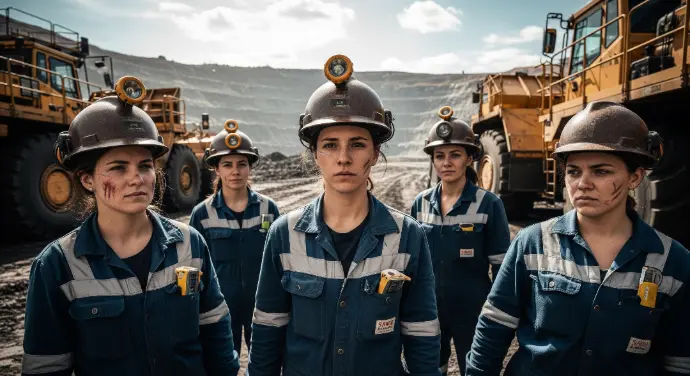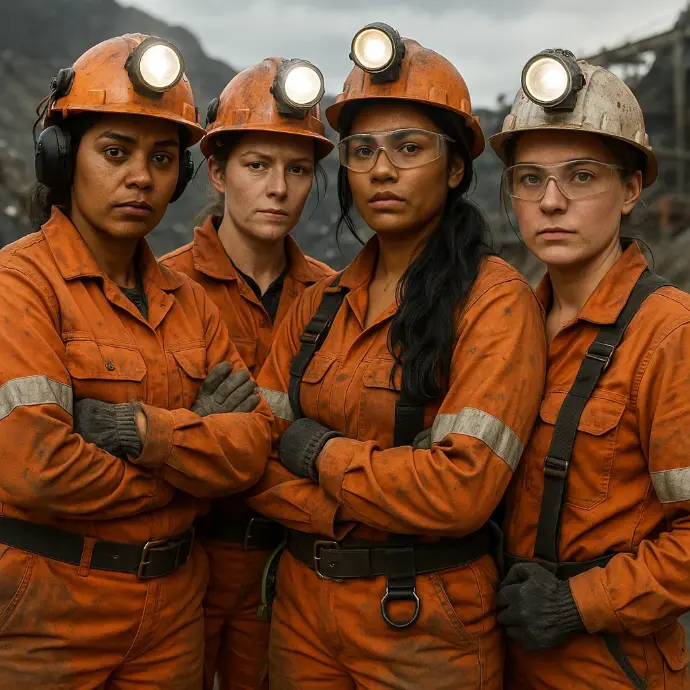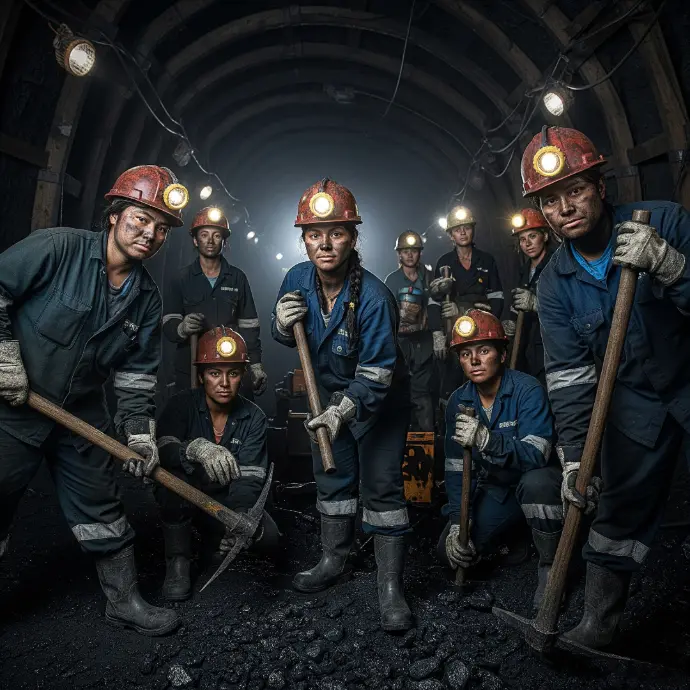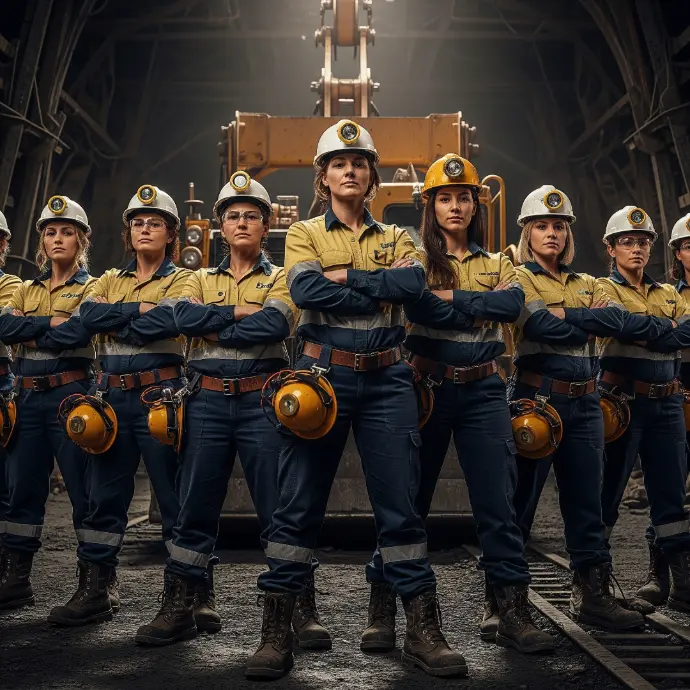Women in the Mine: Gender and Vulnerability in the Extractive Industry
In the article titled "Women in the Mine: Gender and Vulnerability in the Extractive Industry," we propose a comprehensive analysis of the intersection between gender and vulnerability in the mining sector. We invite you to immerse yourself in a study that highlights the challenges women face in this field, urging you to reflect on the importance of safeguarding human rights in all aspects of society. Don't miss this opportunity to delve deeper into an essential topic for justice and equity!
At the heart of the extractive industry, amid the deafening noise of machines and the seemingly all-pervasive dust, women face challenges that go far beyond the inherent occupational hazards. For years, this sector has been practically synonymous with a male-dominated environment, both in terms of physical strength and work culture. However, in recent decades, women have begun to break into a space historically closed to them, facing unique vulnerabilities that deserve to be explored and acknowledged.

Mining, an economic pillar in many countries, presents a complex reality for those involved. For women, this complexity includes structural barriers that stem not only from the nature of the work itself, but also from deep gender inequalities that affect their safety, health, and professional development. Often, working conditions are not designed with the specific needs of female workers in mind: uncomfortable equipment, lack of adequate facilities, and labor standards that ignore gender dynamics are just a few examples.
But the challenges don't end there. Within this environment, many women face sexual harassment, systematic exclusion, and a widespread perception that their presence is limited by traditional roles. These experiences create a dynamic of constant vulnerability that impacts not only their physical and emotional well-being, but also how communities and colleagues perceive their ability to develop professionally in this space.
Despite this, the resilience of women in the extractive sector is worthy of admiration. With courage and determination, they have forced discussions about equity within these industries, challenging traditional paradigms to demonstrate that they can not only perform historically male roles, but also reframe the very concept of what it means to be a mining worker. They have driven initiatives to improve working conditions, demand protection from abuse, and guarantee equal opportunities for all.
In this sense, female inclusion is not only about filling gaps or meeting quotas; it is about generating structural transformations that benefit all workers. A more equitable and safe environment not only benefits women but also contributes to the comprehensive development of the entire extractive industry. Diverse perspectives enrich collective work and generate new opportunities to consider how these sectors can advance sustainability that is not only financial, but also human.

As we continue to explore the role of gender in mining and other extractive industries, it is essential to foster spaces where these issues are openly discussed. Only then can we imagine a future where vulnerability gives way to equality and where everyone has the same tools to face the challenges of hard work underground. These changes are imperative not only for the well-being of women in the mines, but for social and economic progress in general.
The fight for a more inclusive extractive industry continues, and with it the hope of building a sector where historical boundaries are abandoned in favor of true equity. Because when we talk about mining, it's not just about excavating minerals; it's about excavating the injustices that remain entrenched.
Introduction
Gender inclusion in mining is a crucial component for promoting equity and social justice. Historically, this sector has been dominated by men, which has generated significant inequalities in terms of job opportunities and working conditions for women. Gender inclusion not only entails ensuring equal access to jobs in mining, but also ensuring a safe and fair working environment for women workers.
The implementation of policies and practices that promote gender inclusion in mining not only benefits women but also contributes to the sustainable development of mining communities and strengthens the local economy. By recognizing and addressing gender inequalities in this sector, progress can be made toward a more just, diverse, and prosperous industry.
It is important to note that gender inclusion is not limited to labor participation but also includes aspects such as representation in management positions, equal pay, and protection against discrimination and harassment in the workplace.
The extractive industry, which includes mining, plays a fundamental role in the global economy, providing essential raw materials for various industries. However, this industry has been criticized for its negative impact on human rights, especially in local communities and vulnerable groups.
Mining projects often generate conflicts related to access to land, water, and other natural resources, which can result in forced displacement and the loss of livelihoods for local communities. Furthermore, mining can have devastating effects on the environment, directly affecting the health and well-being of people who depend on natural resources for their livelihoods.
In this context, it is crucial that the extractive industry respect and protect human rights, including labor rights, the right to a healthy environment, and the right to participate in decision-making that affects communities. Adopting responsible mining practices is essential to mitigate negative impacts and promote respect for human rights at all stages of mining activities.
The vulnerability of women in mining is a critical issue that requires immediate attention and action. Women working in mines face specific challenges that place them in a situation of greater vulnerability compared to their male colleagues. These challenges include exposure to hazardous working conditions, lack of adequate sanitary facilities, risk of discrimination and harassment, and difficulty balancing work and family responsibilities.
Furthermore, women residing in mining communities may experience indirect impacts of mining activities, such as the breakdown of social structures, increased gender-based violence, and lack of access to basic services. The vulnerability of women in mining is a reflection of broader inequalities in society, and addressing them requires a comprehensive approach that recognizes and addresses the underlying causes of gender discrimination and exclusion.
It is essential to implement policies and programs that specifically address the needs and challenges faced by women in mining, with the goal of ensuring safe, equitable, and human rights-respecting working conditions. Doing so can significantly contribute to creating a more inclusive and fair work environment for all those involved in the mining industry.
The inclusion of women in the mining sector is a highly relevant issue that deserves analysis. According to the International Labor Organization (ILO), it is estimated that approximately 15% of the mining workforce worldwide is made up of women. In countries like South Africa, this percentage is even lower, reaching around 10% of workers in this sector.
Regarding the distribution of roles, women tend to occupy positions primarily in administrative areas, logistical support, and cleaning tasks. In contrast, their representation in roles directly related to extraction or production is considerably lower. This situation highlights a clear gender inequality in the mining industry, which can increase the vulnerability of women working in this field.
Furthermore, it is important to note that women's participation in informal mining, which is often less documented, is significant in many regions. Women frequently participate in artisanal mining, facing precarious and unsafe working conditions. These realities underscore the need to address gender inequalities in the mining industry and ensure the protection of the rights of women working in this sector.

Women in the Mining Industry
The inclusion of women in the mining sector has a long and complicated history. Throughout history, women have held different roles in mineral extraction and mining. Since ancient times, their connection to mining has been evident, although their participation has frequently been minimized and, in many cases, ignored in historical accounts. Women often performed support tasks, such as transporting minerals, sorting materials, and providing food and supplies for those working in the mining industry. Despite this valuable contribution, their role has rarely been recognized in historical literature.
Over time, women's involvement in mining has changed, and today, more opportunities have emerged for them to occupy direct positions in mineral extraction and management. However, significant challenges remain regarding gender equality, job security, and fair working conditions for women in the mining industry. Despite the progress made, women still face barriers related to gender discrimination, lack of access to leadership positions, and exposure to specific risks that affect their health and safety in the mining workplace.
Recognizing the history of women's participation in mining is essential to understanding the current challenges they face and promoting significant change in the mining sector in terms of gender equity and workplace safety.
Currently, women occupy diverse positions within the mining industry, ranging from operating heavy machinery to project management and equipment supervision. Despite this progress, significant challenges persist for them in the mining environment. Lack of equitable access to job opportunities, gender discrimination, wage disparity, and exposure to specific risks to their health and safety are issues that continue to affect women workers in the mining sector.
Additionally, cultural and social barriers often limit women's opportunities to advance their careers in this field. The lack of support policies and programs for women mining workers also perpetuates gender inequality within the sector. Addressing these challenges requires a comprehensive approach that considers both structural barriers and attitudes and perceptions rooted in mining labor culture.
Identifying and addressing the current challenges faced by women in the mining sector is essential to promoting gender equality, workplace safety, and the empowerment of women workers.
Gender stereotypes have a significant impact on the vulnerability of women in the mining industry. Deep-rooted beliefs and cultural expectations about gender roles often perpetuate discrimination and inequality in the mining workforce. These misconceptions can restrict women's opportunities to access leadership positions, engage in training and professional development, and receive fair remuneration.
Furthermore, gender stereotypes can contribute to the creation of a hostile work environment for women, increasing their vulnerability to discrimination, harassment, and exposure to risky work situations. It is essential to challenge and dismantle these deep-rooted beliefs to establish a more inclusive, equitable, and safe work environment for women mining workers. This requires a sustained commitment to education, awareness-raising, and the promotion of gender diversity in the mining sector.
By addressing gender stereotypes, it is possible to reduce women's vulnerability in the mining sector and foster a more fair, safe, and respectful work environment for all those involved in this industry.
Women's empowerment in the mining sector is a fundamental issue for promoting gender equality and improving working conditions in an environment that has historically been dominated by men. Women in mining face specific challenges, such as gender discrimination, limited opportunities for professional development, and exposure to specific workplace risks. To counter these problems, it is crucial to implement programs that provide women miners with access to specialized training, opportunities to assume leadership, and participate in decision-making within mining operations.
Women's empowerment in mining not only benefits individual workers but also promotes the sustainable development of mining communities as a whole. By promoting women's equitable participation in this industry, the diversity of perspectives is enriched, the social fabric is strengthened, and economic advancement is driven. Furthermore, empowering women miners to defend their labor rights and actively participate in collective bargaining processes paves the way for more just and equitable working environments for all workers in the mining sector.
Strengthening the role of women in mining is not only a matter of social equity but is also crucial to improving the efficiency and sustainability of mining activities. Women occupy key positions in the mining value chain, spanning processes from extraction to commercialization, and their full and equitable participation is vital to maximizing the potential of this sector. Promoting women's empowerment in mining fosters the creation of a more inclusive, resilient, and ethical industry that recognizes and appreciates the contributions of all those involved in its operations.

Vulnerability in the Mining Sector
Women in the mining sector operate machinery in a dark and challenging environment, demonstrating their strength in the face of the fragility faced by women in this industry. Female participation in the mining sector entails a series of obstacles and dangers that make them especially vulnerable. Factors such as gender-based discrimination, lack of access to healthcare, and the disproportionate burden of family responsibilities exacerbate this vulnerability.
Additionally, the existence of gender stereotypes within the mining industry can restrict the opportunities available to women in certain job roles or positions, negatively impacting their career advancement and their ability to receive fair treatment in terms of pay and working conditions.
The lack of policies and programs specifically aimed at addressing the needs and challenges faced by women in the mining sector also contributes significantly to their vulnerability, as they lack the necessary protections and support.
The fragility of women in the mining sector has direct consequences for their health and safety. Exposure to harmful and hazardous substances, coupled with a lack of access to adequate personal protective equipment, increases the likelihood of contracting occupational diseases and suffering serious injuries.
Furthermore, the scarcity of sanitary facilities and specialized medical services within mines worsens women's vulnerability, as they face difficulties accessing reproductive health care and receiving timely medical attention during emergency situations.
The vulnerability faced by women in mining also translates into a greater risk of experiencing workplace violence, including sexual harassment and gender-based discrimination, which negatively impacts their emotional and psychological well-being, as well as their sense of safety in the workplace.
The mining sector, which is characterized by a predominantly male environment, presents significant challenges related to gender-based violence and harassment against women. The lack of effective policies to prevent and address these forms of violence contributes to the creation of a hostile and unsafe work environment for women workers in this industry.
Sexual harassment, discriminatory comments, and exclusion from decision-making processes are common forms of gender-based violence in the mining sector, negatively impacting the self-esteem, morale, and overall well-being of women employed in this field.
The precarious situation of women in the mining sector, intensified by gender-based violence and harassment, underscores the imperative to establish inclusive policies and concrete measures that promote gender equality and ensure a respectful and safe work environment for all those involved in the mining industry.
In the mining sector, women face significant difficulties in accessing resources and opportunities. They frequently face cultural and gender-based obstacles that restrict their participation in key positions within the sector. The lack of educational opportunities and specialized training also plays a significant role in the exclusion of women in this field. To address this issue, it is crucial to develop programs that promote gender equity and facilitate equal access to technical and vocational training in the mining sector.
Additionally, it is essential to establish policies that encourage women's active participation in leadership roles and decision-making within mining companies. This will not only provide individual benefits to women but will also enrich the industry by incorporating a diverse perspective. Ensuring that women in mining have equitable access to resources, vocational training opportunities, and representation in management positions will significantly contribute to reducing this group's vulnerability within the extractive sector.
Likewise, it is vital to ensure that women in mining can access adequate health services, including specialized medical care that responds to their gender needs. The creation of policies that facilitate work-life balance is equally essential to supporting women involved in the mining industry, enabling them to balance their work responsibilities with their family obligations.

Human Rights and Legal Protection
In the context of the mining industry, the protection of women's rights is crucial to ensuring a safe and equitable work environment. At the international level, there are various legal instruments that support women's rights in the workplace, including in the extractive industry. The Universal Declaration of Human Rights, the Convention on the Elimination of All Forms of Discrimination against Women (CEDAW), and the United Nations Declaration on the Rights of Indigenous Peoples are just a few of the international legal frameworks that address the protection of women's rights at work, including in mining settings.
At the national level, countries also have specific laws and regulations to protect women's rights in the mining industry. These legal provisions address issues such as equal pay, access to equal employment opportunities, protection against harassment and discrimination, and workplace safety. However, despite the existence of legal frameworks at both the international and national levels, the effective implementation of these measures remains a challenge in many mining contexts.
It is essential that both internationally and nationally promote the effective enforcement of existing laws and regulations to ensure the protection of women's rights in the mining industry. Furthermore, it is necessary to advocate for the creation of policies and practices that ensure safety, equity, and respect for human rights in these work environments.
In the context of the mining industry, women face unique challenges that require the support and protection of alliances and organizations defending the rights of women miners. These organizations play a crucial role in promoting gender equality, workplace safety, and protecting the rights of women workers in the extractive industry.
Alliances and organizations defending the rights of women miners are dedicated to addressing gender inequalities, discrimination, and violence in the workplace. They provide resources, training, and emotional support to women miners, as well as advocate for equitable labor policies and safe and healthy work environments.
Additionally, these organizations work in partnership with mining companies, governments, and other stakeholders to ensure that women's rights are respected and gender issues are addressed in the mining industry. Their work is critical to empowering women miners, improving their working conditions, and promoting gender equality in a historically male-dominated workplace.

Actions and Solutions
The incorporation and strengthening of women's role within the mining sector are essential to advancing gender equality and reducing vulnerability in this workplace. A variety of initiatives have been implemented to promote women's active participation in this industry, offering training opportunities, access to management positions, and establishing safe environments for their professional growth.
These initiatives range from mentoring and technical training programs to the implementation of equal pay and opportunity policies. They also seek to foster the creation of support networks and the establishment of quotas to ensure female representation at all levels of the mining industry. The goal is to generate a cultural change that fosters an inclusive and respectful work environment.
It is essential that these actions be carried out in conjunction with companies, government authorities, and civil society organizations to ensure their effectiveness and long-term sustainability.
The vulnerability experienced by women in the mining industry is an issue that requires special attention due to the unique challenges they face in this environment. Strategies to address this vulnerability range from the implementation of specific safety measures to the adoption of policies that safeguard women's reproductive rights and health.
It is crucial to establish prevention and response protocols for situations of harassment, discrimination, or gender-based violence in mines. Furthermore, the creation of safe spaces and mechanisms for women to report any risk or injustice they encounter in their workplaces should be encouraged.
Additionally, it is essential to promote women's active participation in decision-making processes and in the development of policies that directly affect their working conditions and well-being. The establishment of gender equality committees and the inclusion of a gender perspective in the planning and management of mining operations are fundamental steps to address women's vulnerability in this sector.
Gender training and awareness are essential tools for fostering more inclusive and equitable work environments in the mining industry. Providing training on women's rights, the prevention of harassment and discrimination, and the promotion of equal opportunities contributes to building an organizational culture that values diversity and mutual respect.
Likewise, raising awareness about gender roles and stereotypes in the workplace is essential to identifying and addressing the barriers that hinder women's comprehensive development in the mining sector. This awareness can be achieved through seminars, internal and external communication initiatives, and the incorporation of a gender perspective into all recruitment, selection, and performance evaluation procedures.
Gender training and awareness are not only beneficial for women but also help create fairer, safer, and more productive work environments for the entire mining community.
Gender equality in the extractive sector significantly affects the lives of women employed in mines. Gender inequalities in this workplace can result in lower pay for women compared to their male counterparts, fewer opportunities for career advancement, and greater risks to their health and safety. These differences not only impact women's quality of life in mining but also have negative consequences for their families and communities.
The lack of gender equality in the mining sector is also evident in the limited representation and participation of women in leadership and decision-making positions. The lack of women in management positions restricts diversity of perspectives and the inclusion of gender considerations in the policies and practices of mining companies. This can lead to the implementation of inadequate measures to address the challenges women face in the mining sector, thus perpetuating inequality and vulnerability.
It is essential that mining organizations and governments recognize the negative impacts of gender inequality in the extractive sector and adopt concrete measures to promote equal opportunities, safety, and well-being for women in mining. Implementing equal pay policies, training and professional development programs targeted at women, and creating safe and gender-responsive work environments are crucial steps to reducing the impact of gender inequality in the mining industry.
Conclusions
Safeguarding women's rights in the mining sector remains a challenge in many countries. Despite progress in gender equality regulations and policies, women working in mining face specific difficulties that require special attention. Inadequate access to reproductive health services, workplace discrimination, and exposure to inherent risks are just some of the adversities women encounter in this industry.
It is essential to highlight the delicate situation women experience in the mining sector and to establish concrete actions to help reduce these risks. Raising awareness about gender disparities in the mining sector is the first step in addressing these issues. Likewise, targeted policies must be implemented to safeguard women's rights in mining and encourage their active participation at all levels of the industry. Women's education and empowerment are essential to achieving significant change in this area.
To achieve gender equality in the extractive industry, it is crucial to promote concrete initiatives at the institutional, governmental, and corporate levels. This includes establishing gender quotas, developing training and leadership programs for women miners, and creating safe and discrimination-free work environments. Cooperation between the private sector, government entities, and civil society is vital to moving toward a more inclusive and equitable mining industry for all involved.

 IHRO NEWS
IHRO NEWS